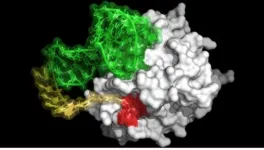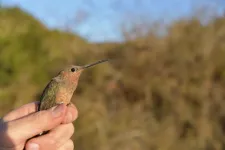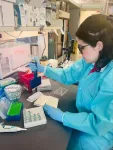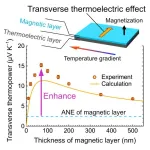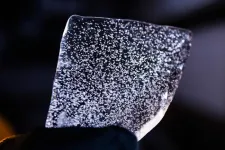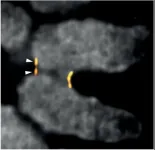(Press-News.org)
In a new study, led by Charles Underwood from the Max Planck Institute for Plant Breeding Research (MPIPZ) in Cologne, Germany, scientists established a system to generate clonal sex cells in tomato plants and used them to design the genomes of offspring. The fertilization of a clonal egg from one parent by a clonal sperm from another parent led to plants containing the complete genetic information of both parents. The study is now published in Nature Genetics.
Hybrid seeds, combining two different parent lines with specific favorable traits, are popular in agriculture as they give rise to robust crops with enhanced productivity, and have been utilized by farmers for over a hundred years.
The increased performance of hybrids is generally known as hybrid vigour, or heterosis, and has been observed in many different plant (and animal) species. However, the heterosis effect no longer persists in the subsequent generations of these hybrids due to the segregation of genetic information. Thus, new hybrid seeds need to be produced every year, a labor-intensive and expensive endeavor that doesn't work well for every crop.
So, how can the beneficial traits, encoded in the genes of hybrid plants, be transferred to the next generation?
Typically, our genetic material undergoes reshuffling during meiosis – a crucial cell division occurring in all sexually reproducing organisms. This reshuffling, due to random segregation of chromosomes and meiotic recombination, is important in generating novel and beneficial genetic configurations in natural populations and during breeding.
However, when it comes to plant breeding, once you have a great combination you want to keep it and not lose it by reshuffling the genes again. Having a system that bypasses meiosis and would result in sex cells (egg and sperm) that are genetically identical to the parents could have several applications.
In this study, Underwood and his team established a system, in which they replace the meiosis by mitosis, a simple cell division, in the most popular vegetable crop plant, the cultivated tomato. In the so-called MiMesystem (Mitosis instead of Meiosis) the cell division mimics a mitosis, thus sidestepping genetic recombination and segregation, and produces sex cells that are exact clones of the parent plant. The concept of the MiMesystem has previously been established by MPIPZ director Raphael Mercier in Arabidopsis and rice.
A breakthrough aspect of the new study is that for the first time the researchers harnessed the clonal sex cells to engineer offspring through a process they call “polyploid genome design”.
Usually, sex cells have a halved chromosome set (in humans, 46 chromosomes reduces to 23; in tomato 24 chromosomes reduces to 12) whereas the MiMe sex cells are clonal and therefore this halving of the chromosome set does not happen. Underwood and his team performed crosses that meant that the clonal egg from one MiMe tomato plant was fertilized by a clonal sperm from another MiMe tomato plant. The resulting tomato plants contained the complete genetic repertoire of both parents – and is thereby made up of 48 chromosomes. Hence all favourable characteristics from both hybrid parents are consolidated – by design – in one novel tomato plant.
Because of the close genetic relationship between tomatoes and potatoes, the team around Underwood believes that the system described in this study can be easily adapted for use in potato, the world’s fifth most valuable crop plant, and potentially other crop species.
In view of rising population figures and climatic changes, the development of high-yielding, sustainable, and stable varieties is crucial to securing the world's food supply in the long term. Therefore, it is critical to cultivate plants that exhibit heightened disease resistance and stress tolerance. Innovative approaches to plant reproduction technologies are essential. The MiMe system and its application in polyploid genome engineering could be one promising avenue to tackle today’s agricultural challenges.
“We are really excited about the possibility of using clonal sex cells to carry out polyploid genome design. We are convinced this will allow breeders to untap further heterosis - the progressive heterosis found in polyploids – in a controlled manner”, says Charles Underwood.
“The tomato MiMe system we have established could also be used as a component of clonal seed production - synthetic apomixis - in the future. This could massively reduce the cost of producing hybrid seeds”, adds Yazhong Wang.
END
DURHAM, N.C. – Nature gave ticks, mosquitos and leaches a quick-acting way to keep blood from clotting while they extract their meal from a host.
Now the key to that method has been harnessed by a team of Duke researchers as a potential anti-clotting agent that could be used as an alternative to heparin during angioplasty, dialysis care, surgeries and other procedures.
Publishing in the journal Nature Communications, the researchers describe a synthetic molecule that mimics the effects of compounds in the saliva of blood-sucking critters. Importantly, the new molecule can also ...
Toronto, ON - A new national study found that transgender preteens, 12 and13 years old, reported 13 hours of daily recreational screen time, which was 4.5 hours more than their cisgender peers. Data were collected from 2019 to 2021, overlapping with the COVID-19 pandemic, and the study was published in Annals of Epidemiology.
“Transgender adolescents are more likely to experience school-based bullying and exclusion from peer groups due to their gender identity, leading them to spend less time in traditional school activities and more time on screens,” says lead author, Jason Nagata, MD, associate professor of pediatrics at the University of California, San Francisco. ...
For release: May 13, 2024
Ithaca, NY—The Giant Hummingbird of western South America is not one species but two, according to an international group of researchers. The northern population stays in the high Andes year-round while the southern population migrates from sea level up to 14,000 feet for the nonbreeding months. The two species appear identical. But looks deceive—their genomes and behaviors tell a different story. The paper announcing the find was published this week in the journal Proceedings of the National Academy of Sciences.
“These ...
In the weeks before and after the 2020 presidential election, researchers ran a number of tests to try to understand how much Facebook and its corporate cousin, Instagram, may be contributing to the nation's political divide.
One of those experiments — led by Matthew Gentzkow and Hunt Allcott, economics professors at Stanford University — centered on more than 35,000 Facebook and Instagram users who were paid to stay off the platforms in the run-up to Election Day. There’s a lot that researchers could glean from the social media hiatus, including whether people’s political attitudes shifted and in what ways. If views changed dramatically, that ...
Researchers from UNM’s Museum of Southwestern Biology (MSB) have uncovered the giant hummingbird’s extreme long-distance migration for the first time. Their eight-year study, Extreme elevational migration spurred cryptic speciation in giant hummingbirds published this week in Proceedings of the National Academy of Sciences, led them to another important discovery: The world’s largest hummingbird is a new species.
The team, led by Jessie Williamson, UNM Ph.D., 2022, included the Museum of Southwestern Biology at UNM, Pontificia Universidad Católica de Chile in Chile, and Centro de Ornitología ...
A newly discovered Zika virus-specific synthetic molecule is capable of differentiating Zika-immune patient samples from samples of patients previously infected with the related dengue virus. The technology may lead to the development of better diagnostics and vaccine candidates, scientists announced today in the Proceedings of the National Academy of Sciences.
The study, led by researchers at the University of Pittsburgh School of Public Health and The Herbert Wertheim UF Scripps Institute for Biomedical Innovation & Technology, is the first to apply an innovative “epitope surrogate” technology to Zika. Until now, researchers and clinicians have lacked diagnostic ...
A way to curb nagging insects has been flying under our radar—an enzyme from fruit fly testes.
The compound could control bugs that carry disease and harm crops by stunting their ability to procreate, Johns Hopkins University researchers found.
“We have a toe in the door to control fruit fly populations with this enzyme,” said Steven Rokita, a professor of chemistry at Johns Hopkins who led the research. “It could offer a good way to control fertility of all kinds of biological and agricultural pests, starting with mosquito populations.”
The findings are set to publish ...
1. A NIMS research team has demonstrated for the first time ever that a simple stack of thermoelectric and magnetic material layers can exhibit a substantially larger transverse thermoelectric effect—energy conversion between electric and heat currents that flow orthogonally to each other within it—than existing magnetic materials capable of exhibiting the anomalous Nernst effect. This mechanism may be used to develop new types of thermoelectric devices useful in energy harvesting and heat flux sensing.
2. Seebeck effect-based ...
CORVALLIS, Ore. – Today’s rate of atmospheric carbon dioxide increase is 10 times faster than at any other point in the past 50,000 years, researchers have found through a detailed chemical analysis of ancient Antarctic ice.
The findings, just published in the Proceedings of the National Academy of Sciences, provide important new understanding of abrupt climate change periods in Earth’s past and offer new insight into the potential impacts of climate change today.
“Studying the ...
Researchers from the Kops group in collaboration with researchers from the University of Edinburgh, made a surprising new discovery in the structure of the centromere, a structure that is involved in ensuring that chromosomes are segregated properly when a cell divides. Mistakes in chromosome segregation can lead to cell death and cancer development. The researchers discovered that the centromere consists of two subdomains. This fundamental finding has important implications for the process of chromosome segregation and provides new mechanisms underlying erroneous divisions in cancer cells. The research was published in Cell on May 13th 2024.
Our bodies consist of trillions of ...
